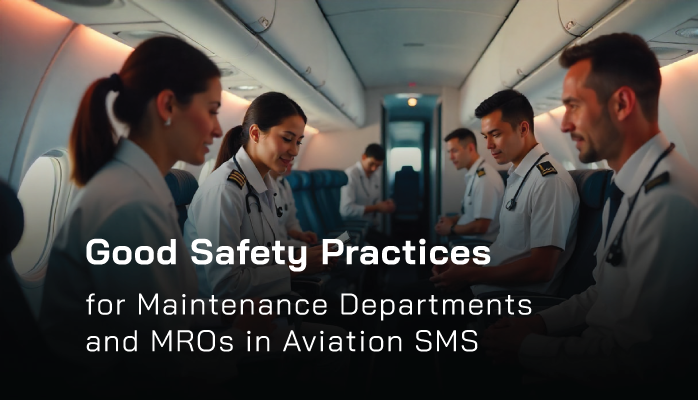4 Aviation Safety Management Practices to Apply in Aviation Maintenance

In aviation maintenance, as in all other aspects of the aviation sector, safety is paramount. 4 safety management practices that can be applied to make any maintenance operation safer are:
- Use of tangible metrics to measure effectiveness
- Open communication between management and operational employees;
- Policies that distinguish willful acts of misconduct from inadvertent errors.
Why do we focus on maintenance in this article? Because maintenance-related accidents are probably the most avoidable of all accidents, and if maintenance is within the domain of your operations then it may be the first place you stress things like:
- Reporting policies;
- Feedback; and
- Safety promotion.
Other sectors of operations, such as flight operations, may benefit more from things like Human Factors training and emergency response training.
Related Aviation Safety Practices Articles
- 10 Best Ways to Promote Safety in Your Aviation SMS [With Free Checklist]
- Examples of Good Hazard Reporting Forms in Aviation Safety
- How to be ICAO Compliant With Safety Communication
Measure SMS Performance in Maintenance Departments With Lost Time Injury Metrics
Most successful maintenance organizations have tangible safety metrics that help define their results in terms of safety. For instance, lost-time injury frequency is a metric used to identify potentially unsafe maintenance practices or procedures:
- Back injuries and falls are common injuries at overhaul facilities; and
- Lacerations and other types of cuts requiring hospitalization (i.e., stitches) are also common when working on.
These types of injuries, among many others common to maintenance operators, involve lost time. By analyzing lost-time injury frequency metadata, procedures, and checklists can be put in place to prevent injuries. Some metadata you may analyze to know how to improve safety in maintenance operations are:
- Time of injury data;
- Job task injury data;
- Location data;
- Type of vehicle/aircraft data; and
- Policies/procedures associated with job task data.
Improve Maintenance Safety by Constant Communication

Many of us have dealt with situations where communications between management and those performing the work have broken down. In fact, creating positive employee-management relations is something many organizations put much time and effort into cultivating.
Maintaining a relationship that sticks to the rules but has an “open door” feel is tough. Poor communication leads to
- An increase in errors;
- Unsafe working conditions; and
- Potentially hazardous situations.
In large organizations open communication starts at the ground level through:
- Open door policies;
- Regular feedback;
- Trust in decision making of subordinates; and
- Promoting from within the organization.
The last point is key. You should try hard to promote from within the ranks of your organization. If there are no qualified candidates, encourage top-performing workers to get the qualifications they need to be promoted, such as via paid education programs.
Train Employees on Good/Bad Behavior With Policies
According to James Reason in the paper A Roadmap to Just Culture: Enhancing the Safety Environment, “A safety culture depends critically upon first negotiating where the line should be drawn between unacceptable behavior and blameless unsafe acts”.
In aviation maintenance errors happen all the time. Mechanics break things in the process of trying to fix them and often that happens because of an honest mistake.
You need to distinguish these types of issues from instances of willful misconduct. Fortunately, the frequency of such acts is small compared to the number of honest mistakes that are made in the course of regular maintenance.
You distinguish these acts in your Safety Policy by
- Defining “will acts of misconduct”;
- Giving examples of honest mistakes vs willful acts; and
- Clarify how each mistake/willful act will be dealt with by the company.
The underlying purpose of promoting this information is actually to show that your company is committed to a non-punitive reporting policy. This is because, as said, willful acts are uncommon. Furthermore, because nearly all mistakes will be honest, you want to reinforce the idea that your company accepts that such mistakes will happen and that employees won’t be punished.
Related Articles on Aviation SMS Training
- 4 Pillars | 10 Things You Need to Know About Aviation Safety Training
- How Recurrent Aviation SMS Training Makes Good Business Sense
- Advanced Topics for Human Factors Aviation SMS Training
Final Thought: Conclusion on Safety in Maintenance Field
In conclusion, safety is a top priority in the aviation sector. From my time in the aviation field and the classroom, the application of these 3 key practices described above would result in positive safety outcomes in the aviation maintenance sector.
Last updated August 2025.





